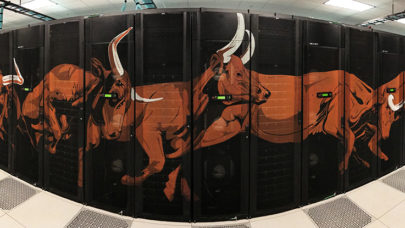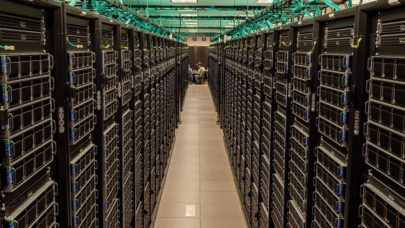
TACC Champions AI Progress with Inclusion of Frontera and Lonestar6 in NAIRR Pilot
February 2, 2024
The Texas Advanced Computing Center is poised to play a pivotal role in the recently announced National Artificial Intelligence Research Resource (NAIRR) pilot, Read more…

HPC User Forum: Sustainability at TACC Points to Software
October 3, 2023
Recently, Dan Stanzione, Executive Director, TACC and Associate Vice President for Research, UT-Austin, gave a presentation on HPC sustainability at the Fall 20 Read more…

TACC’s New Stampede3 Enhances NSF Supercomputing Ecosystem: Interview
July 24, 2023
The Texas Advanced Computing Center (TACC) today announced Stampede3, a powerful new Dell Technologies and Intel based supercomputer that will enable groundbrea Read more…

TACC Supercomputing Powers Climate Modeling for Fisheries
January 28, 2023
A tremendous portion of the world depends on the output of the oceans’ major fisheries, which have, in recent decades, found themselves under near-constant th Read more…

More Details on ‘Half-Exaflop’ Horizon System, LCCF Emerge
September 26, 2022
Since 2017, plans for the Leadership-Class Computing Facility (LCCF) have been underway. Slated for full operation somewhere around 2026, the LCCF’s scope ext Read more…

Supercomputing an Image of Our Galaxy’s Supermassive Black Hole
May 13, 2022
A supermassive black hole called Sagittarius A* (yes, the asterisk is part of it!) sits at the center of the Milky Way. Now, for the first time, we can see it. The resulting direct image of Sagittarius A*, revealed this week, was made possible by the Event Horizon Telescope (EHT) array and the Frontera supercomputer at the Texas Advanced Computing Center (TACC). The EHT array includes a selection of eight radio telescopes... Read more…

TACC Looks to ‘Horizon’ System for Its Leadership-Class Computing Facility
April 14, 2022
During a talk for the Ken Kennedy Institute’s 2022 Energy High Performance Computing Conference, Dan Stanzione, executive director of the Texas Advanced Compu Read more…

Supercomputers Delve Into Underwater Mystery
April 8, 2022
The inner workings of the Earth shape the continents and islands we know on the surface — but many of the inner workings of the planet remain a mystery to eve Read more…

- Click Here for More Headlines

Whitepaper
Transforming Industrial and Automotive Manufacturing
In this era, expansion in digital infrastructure capacity is inevitable. Parallel to this, climate change consciousness is also rising, making sustainability a mandatory part of the organization’s functioning. As computing workloads such as AI and HPC continue to surge, so does the energy consumption, posing environmental woes. IT departments within organizations have a crucial role in combating this challenge. They can significantly drive sustainable practices by influencing newer technologies and process adoption that aid in mitigating the effects of climate change.
While buying more sustainable IT solutions is an option, partnering with IT solutions providers, such and Lenovo and Intel, who are committed to sustainability and aiding customers in executing sustainability strategies is likely to be more impactful.
Learn how Lenovo and Intel, through their partnership, are strongly positioned to address this need with their innovations driving energy efficiency and environmental stewardship.
Download Now
Sponsored by Lenovo
Whitepaper
How Direct Liquid Cooling Improves Data Center Energy Efficiency
Data centers are experiencing increasing power consumption, space constraints and cooling demands due to the unprecedented computing power required by today’s chips and servers. HVAC cooling systems consume approximately 40% of a data center’s electricity. These systems traditionally use air conditioning, air handling and fans to cool the data center facility and IT equipment, ultimately resulting in high energy consumption and high carbon emissions. Data centers are moving to direct liquid cooled (DLC) systems to improve cooling efficiency thus lowering their PUE, operating expenses (OPEX) and carbon footprint.
This paper describes how CoolIT Systems (CoolIT) meets the need for improved energy efficiency in data centers and includes case studies that show how CoolIT’s DLC solutions improve energy efficiency, increase rack density, lower OPEX, and enable sustainability programs. CoolIT is the global market and innovation leader in scalable DLC solutions for the world’s most demanding computing environments. CoolIT’s end-to-end solutions meet the rising demand in cooling and the rising demand for energy efficiency.
Download Now
Sponsored by CoolIT
Advanced Scale Career Development & Workforce Enhancement Center
Featured Advanced Scale Jobs:
HPCwire Resource Library
HPCwire Product Showcase
© 2024 HPCwire. All Rights Reserved. A Tabor Communications Publication
HPCwire is a registered trademark of Tabor Communications, Inc. Use of this site is governed by our Terms of Use and Privacy Policy.
Reproduction in whole or in part in any form or medium without express written permission of Tabor Communications, Inc. is prohibited.
























